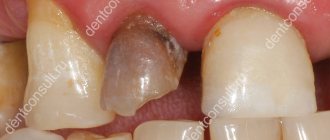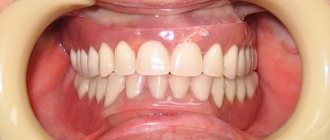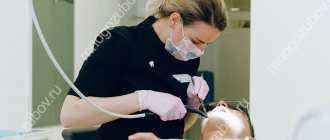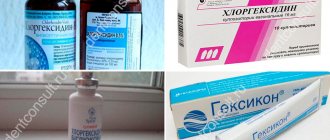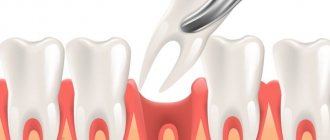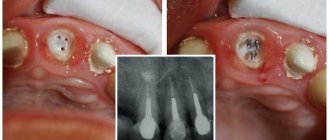Tooth decay has not been a problem for dentists for a long time. In this case, it is not necessary to remove the root and place an implant. If the tooth is at least partially preserved, it can be restored using a pin. This design allows you to grow a new tooth or install a crown, while returning it to its original functionality and appearance. Pin technology is not complicated and quite reliable, so it is often used to solve dental problems.
Pin in a tooth - what is it?
Phrases from the series “putting a tooth on a pin,” “building a tooth on a pin,” or “tooth under a pin” sound quite scary for many patients. However, in reality, restoring a tooth with a pin will help avoid its removal, and the design itself does not cause any discomfort. A dental pin is placed into the root canal. The device performs a supporting function and helps to optimally distribute the load on the tooth. Since a pin is placed in the root of the tooth, a number of therapeutic and endodontic procedures must be carried out before starting treatment.
Indications for installing a pin in a tooth
- Serious damage to the coronal part. A tooth without a post has a higher risk of destruction after treatment if more than 50% of its visible part is initially damaged.
- Repeated dental treatment due to secondary caries or destruction of tooth tissue due to other reasons.
- The need for additional supporting and fixing elements for installing a crown.
- When preparing the abutment tooth for fixing the prosthesis.
- For the treatment of advanced forms of periodontitis and periodontal disease. Pins are installed on loose teeth for subsequent splinting.
- During tooth replantation (in rare cases).
Contraindications to the procedure are related to the condition of the tooth (severe damage, too thin walls), anatomical features and pathologies of the root canal structure, as well as concomitant diseases (caries, acute periodontitis, cyst, granuloma, abscess, mental disorders) and body conditions (pregnancy) .
Terms of use
Not every patient can receive a pin support. To securely hold the structure, two basic conditions must be met:
- the thickness of the root wall should not exceed two millimeters;
- if necessary, you can unseal the canal by 2/3 of its length (this situation arises if the roots have already been filled).
Contraindications to implantation are:
- very thin root walls;
- advanced inflammatory process;
- untreated granuloma, cyst;
- pregnancy;
- obstruction and severe tortuosity of the root mouth, the inability to carry out its high-quality processing.
Dental pins - what are they?
Today, doctors have a wide selection of dental pins, varying in shape, material and area of application.
Dental pin materials
- Metal.
The most popular options: titanium, brass, palladium and precious alloys. - Metal-free.
They are made from gutta-percha, ceramics, fiberglass and carbon fiber.
Forms
- screw
- cylindrical
- conical
- combined
Recovery methods
- pins for tooth crown
- tooth filling on a pin
Mounting methods
- Active.
Threaded pins are screwed into the root canal, thereby achieving a tighter fixation. However, there is a risk of perforation of the canal walls. - Passive.
A more gentle (but less reliable) method of fastening. The pin is placed inside the root canal and fixed using a special compound.
Types of dental pins
Gutta-percha
Filling dental canals with gutta-percha pins allows you to achieve predictable results, since the entire root canal cavity is filled. However, the gutta-percha pin cannot perform a full support function.
Metal pins in teeth (anchors)
Most types of anchor pins are made of metal, threaded, and installed using the active method. An anchor pin in a tooth is a classic option that is most often used for fixing crowns (a crown on a tooth on a pin). There are also modern analogues: these pins have a smooth surface and are made of ceramic, but some experts no longer call these products anchors.
Fiberglass
Fiberglass teeth pins are sufficiently strong, elastic and safe. They are almost transparent, so they are actively used to restore teeth in the smile area. The front tooth on a fiberglass post looks quite aesthetically pleasing, since the material does not stain over time and is generally quite durable.
Carbon fiber
Another type of modern and popular pins, which are as similar as possible to the structure of dental tissues. They are very durable, help to optimally distribute the load and prevent root fractures.
Attention!
To restore teeth, pin inlays are also used - these are solid structures made of metal alloys or ceramics, the base of which is installed in the root canals, and the stump imitates part of the crown.
How is a pin inserted into a tooth?
Installing a pin into the root of a tooth is a rather labor-intensive process, including diagnosis and preliminary treatment of canals. Further actions depend on the treatment method. The first option is to place a pin and build up the tooth using composite materials. The second option, a tooth prosthesis on a pin, involves installing a crown. Dental prosthetics with a pin is not performed. The role of the prosthesis is performed by the crown, and the pin is only an additional supporting element. Finally, the extended tooth on the pin is polished and brought into proper condition. In the case of a crown, the doctor makes sure that the prosthetics was successful.
Installing a seal
If most of the unit remains in good condition, it is restored according to the following scheme:
- Carrying out X-ray diagnostics. Using the image, the doctor examines the degree of tortuosity and depth of the canals, their condition, and determines whether it will be possible to fix the element.
- Sanitation of the oral cavity. All carious areas are treated. If pulpitis, gingivitis or any other dental disease is diagnosed, it is treated.
- Preparing the roots. The pulp is removed, the roots are cleaned mechanically, and then washed with an antiseptic. The channels are given the required shape.
- Installation of an artificial rod. It is fixed with heavy-duty cement.
- Extension of the coronal part. When the cement hardens, a photopolymer composite is applied layer by layer to the protruding part of the support.
Immediately after restoration procedures, the patient goes home.
Titanium pin in tooth
The pins located in the tooth canals can be made of titanium, but they should not be confused with implants. Dental pins belong to endodontics and partly to orthopedics, while implantation is a separate area. When a titanium pin is placed in an extracted tooth, the product is called an “implant.” This is an artificial root that is implanted in place of a lost tooth. Theoretically, a dental implant can be called a titanium post (which many people often do), but compared to classic posts, it performs a completely different function. The advantages of implantation today are undeniable: if a natural tooth is lost, it is the implant that can best restore its functionality and aesthetics.
What to do if a tooth with a pin hurts?
Painful sensations may well occur after installation of the pin, since surrounding tissues were affected during the treatment process. Often, unpleasant sensations occur after depulpation, especially with the use of arsenic. A tooth without a nerve and a pin should not hurt, since it is dead. If a tooth hurts after installing a pin and these sensations do not go away for several days, there is a risk that the treatment was carried out with errors and complications arose. In this case, you should consult a doctor as soon as possible.
Care
In the postoperative period, which can last up to several months, the patient must adhere to a number of recommendations. Thanks to this, he will be able to protect the pin prosthesis from damage and avoid unwanted complications.
Everything you need to know about gutta-percha points
Among the most important of them, experts highlight the following:
- During the first few days, rinse your mouth with antiseptic agents.
- In the evening, clean your teeth from food debris and plaque using dental floss.
- In the first few weeks after installation, exclude from the diet foods that require excessive jaw activity. The food should be fairly soft, and ideally ground.
- On the first day after surgery, avoid cleaning the oral cavity, and then carry out all necessary hygiene procedures twice a day.
- Avoid contact of teeth with anything that can lead to damage to their integrity (toothpicks, nuts, seeds).
- your dentist regularly (at least once every six months) and strictly follow all recommendations given by him.
The hardening process of the extended tooth lasts several days. During this period, it is extremely important to avoid the consumption of strong tea, coffee, as well as foods and drinks that contain natural or synthetic dyes.
Is it worth putting a pin in a tooth?
Like all dental treatment methods, pins have their drawbacks. This list is small, but these nuances must be kept in mind before agreeing to treatment.
- Allergic reactions to metal alloys are possible.
- Even with ideal treatment, a tooth with a pin will be more vulnerable than a healthy tooth. Its service life is shortened and the tooth becomes more fragile.
- The risk of root fracture increases (especially when using classic anchor pins).
On the other hand, this technique allows you to save a tooth in almost hopeless conditions.
Advantages and disadvantages of the technique
Doctors include the following main advantages of using dental pins:
- ease of installation;
- affordable price;
- high strength characteristics;
- sufficient aesthetics of the restored crown.
Among the disadvantages:
- low reliability, risk of the support falling out of the socket when creating a significant chewing load;
- the likelihood of developing an allergic reaction;
- the appearance of an unpleasant metallic taste in the mouth if the support was made of metal;
- relatively short service life.
To ensure that the restored unit is preserved as long as possible, it is important for the patient to follow the doctor’s instructions. It is necessary to avoid eating very hard foods, carefully monitor your oral health, and use dental floss regularly. If chips or cracks appear on the surface of the artificial unit, you should immediately make an appointment at the dental clinic.
